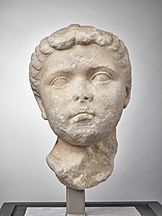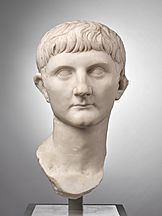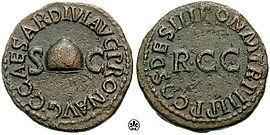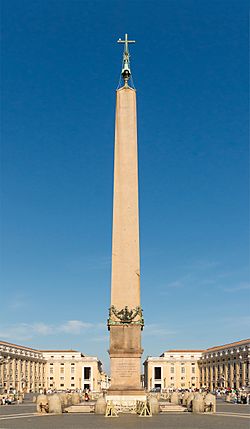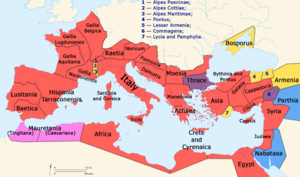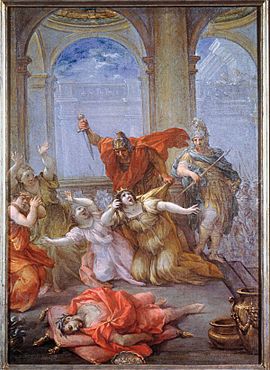Caligula facts for kids
Quick facts for kids Caligula |
|||||
|---|---|---|---|---|---|
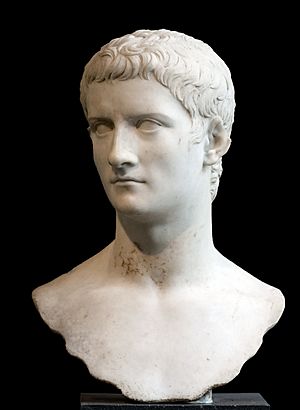
Marble bust of Caligula dating from his reign, now at the Metropolitan Museum of Art
|
|||||
| Roman emperor | |||||
| Reign | 16 March 37 – 24 January 41 | ||||
| Predecessor | Tiberius | ||||
| Successor | Claudius | ||||
| Born | Gaius Julius Caesar 31 August AD 12 Antium, Italy |
||||
| Died | 24 January AD 41 (aged 28) Palatine Hill, Rome, Italy |
||||
| Burial | Mausoleum of Augustus | ||||
| Spouse |
|
||||
| Issue |
|
||||
|
|||||
| Dynasty | Julio-Claudian | ||||
| Father | Germanicus | ||||
| Mother | Agrippina | ||||
Gaius Julius Caesar Augustus Germanicus (born August 31, AD 12 – died January 24, AD 41) was the third Roman emperor. He ruled from AD 37 until he was killed in AD 41. Most people know him by his nickname, Caligula.
Caligula was the son of a famous Roman general named Germanicus. His mother, Agrippina the Elder, was the granddaughter of Augustus, the first Roman emperor. Caligula was part of the first ruling family of the Roman Empire, known as the Julio-Claudian dynasty.
His real name was Gaius, like Julius Caesar. But soldiers gave him the nickname "Caligula," which means "little boot." This was because he wore tiny soldier's boots when he was a child with his father's army.
When Germanicus died, Caligula's family faced many challenges. Caligula was the only male survivor of his immediate family. He later lived with Emperor Tiberius on the island of Capri. After Tiberius died in AD 37, Caligula became the new emperor.
Some old writings say Caligula was a good and fair ruler for his first six months. After that, these writings describe him as cruel and extravagant. They often show him as an unstable ruler. It's important to remember that these old sources might not be fully accurate.
During his short time as emperor, Caligula worked to make the emperor's power stronger. He started many big building projects, including two important aqueducts in Rome. The Roman Empire also took over the kingdom of Mauritania during his rule.
In AD 41, Caligula was killed by a group of guards, senators, and other officials. His death stopped their plan to bring back the Roman Republic. Instead, the guards made Caligula's uncle, Claudius, the next emperor.
Contents
- Becoming Emperor: Caligula's Early Life
- Caligula's Time as Emperor
- Caligula in Books and Movies
- Images for kids
- See also
Becoming Emperor: Caligula's Early Life
Right: Marble portrait of Germanicus, Caligula's father
Caligula was born in Antium, Italy, on August 31, AD 12. He was the third of six children born to Germanicus and Agrippina the Elder. Germanicus was a grandson of Mark Antony. Agrippina was the granddaughter of Augustus, the first emperor. Caligula was also the nephew of Claudius, who would later become emperor.
He had two older brothers, Nero and Drusus. He also had three younger sisters: Agrippina the Younger, Julia Drusilla, and Julia Livilla.
When Caligula was just two or three years old, he went with his father, Germanicus, on military trips. He wore a small soldier's uniform, including tiny army boots called caligae. This is how he got his famous nickname, Caligula, meaning "little boot." He reportedly grew to dislike this nickname.
Family Challenges and Survival
Germanicus died in AD 19 when Caligula was young. After his father's death, Caligula lived with his mother. However, his mother's relationship with Emperor Tiberius became difficult. Tiberius did not want Agrippina to remarry.
In AD 29, Caligula's mother and his brother Nero were sent away from Rome. His brother Drusus was imprisoned in AD 30. Caligula was then sent to live with his great-grandmother, Livia, and later his grandmother, Antonia Minor.
In AD 31, Caligula went to live with Emperor Tiberius on the island of Capri. He stayed there for six years. Many people were surprised that Tiberius spared Caligula. Roman historians say Caligula was very good at hiding his true feelings. He acted like a loyal servant to Tiberius.
Some stories say Caligula thought about killing Tiberius to get revenge for his family. But he never did. Tiberius supposedly knew about this plan but did nothing. In AD 33, Tiberius gave Caligula an honorary position as a quaestor. This was a step towards a political career.
While Caligula was with Tiberius, his mother and brother Drusus died in prison. Caligula briefly married Junia Claudilla in AD 33, but she died the next year. Caligula made friends with Naevius Sutorius Macro, an important guard leader. Macro helped Caligula by speaking well of him to Tiberius. In AD 35, Caligula was named a joint heir to Tiberius's wealth.
Caligula's Time as Emperor
The Start of His Rule
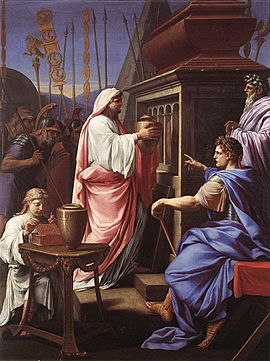
Emperor Tiberius died on March 16, AD 37. He left his power and wealth to Caligula and Tiberius's grandson, Tiberius Gemellus. They were supposed to rule together. Some old historians thought Tiberius might have been murdered.
Caligula, with the help of Macro, had Tiberius's will changed to remove Gemellus. The Roman Senate declared Caligula emperor on March 18. He entered Rome on March 28 to huge crowds. People cheered him as "our baby" and "our star."
Early accounts say Caligula was admired by everyone. People loved him because he was the son of the popular Germanicus. They also liked him because he was different from Tiberius. One historian said over 160,000 animals were sacrificed in three months to celebrate his new rule.
Caligula's first actions were seen as generous. He gave money to the military, including the Praetorian Guard. He destroyed old treason papers and ended treason trials. He helped people who had problems with taxes. He also put on exciting public shows, like gladiatorial games. Caligula even brought back the bones of his mother and brothers to be buried in the tomb of Augustus.
Changes in Caligula's Rule
In October AD 37, Caligula became very ill. After he recovered, many believed his personality changed. He began to remove or exile people close to him. He saw them as threats to his power.
He had his cousin and adopted son, Tiberius Gemellus, executed. He also had his father-in-law and brother-in-law killed. His uncle Claudius was spared, possibly because Caligula found him amusing. His favorite sister, Julia Drusilla, died in AD 38. His other two sisters were sent away from Rome.
Public Projects and Money Matters
In AD 38, Caligula focused on improving public life. He made government money records public, which Tiberius had kept secret. He helped people who lost homes in fires. He also removed some taxes and gave prizes at sports events. He allowed new members into important Roman groups.
He also brought back the practice of elections. One historian, Cassius Dio, said this pleased the common people. But some wise people worried that it might lead to problems. Around this time, Caligula was also criticized for executing people without fair trials.
Financial Challenges
Historians say a money crisis began in AD 39, or perhaps AD 38. Caligula's spending on political support, gifts, and grand events had used up the government's money. Old writings claim Caligula started falsely accusing people to take their wealth.
He asked the public to lend money to the government. He also added taxes on things like lawsuits and weddings. Caligula even auctioned off the lives of gladiators at shows to raise money. Some historians question how bad the money problems truly were. They point out that Caligula's successor, Claudius, still had enough money to pay the Praetorian Guard.
Building Projects and Senate Issues
Despite money issues, Caligula started many building projects. Some were for the public, and others were for himself. He improved harbors to help bring in more grain. He finished the Temple of Divus Augustus and the theatre of Pompey. He also started building an amphitheater.
Caligula began building two impressive aqueducts, the Aqua Claudia and the Anio Novus. He also built a large racetrack called the circus of Gaius and Nero. He had a tall Egyptian obelisk brought to Rome and placed in the middle of the racetrack.
He repaired city walls and temples in Syracuse. He built new roads and kept old ones in good condition. Caligula even planned to dig a canal through the Isthmus of Corinth in Greece.
The Floating Bridge
In AD 39, Caligula did something spectacular. He ordered a temporary floating bridge to be built. It stretched over two miles across the Bay of Baiae using ships as pontoons. This was said to be a challenge to a prediction that he would never be emperor if he rode a horse across the bay. Caligula, who could not swim, rode his favorite horse, Incitatus, across the bridge.
Caligula also had two huge ships built for himself. They were found at the bottom of Lake Nemi around 1930. These ships were among the largest in the ancient world. One was like a temple, and the other was a floating palace with marble floors.
Problems with the Senate
In AD 39, Caligula's relationship with the Roman Senate got worse. The Senate had become used to having more power. Caligula reviewed old records and decided many senators were not trustworthy. He started new investigations and trials. He even had some senators killed.
Soon after, Caligula faced several plots against him. A plot involving his brother-in-law was stopped in AD 39. Another plot led to the execution of a governor in Germany.
Expanding the Empire
In AD 40, Caligula expanded the Roman Empire into Mauritania. This was a kingdom that was allied with Rome. Caligula invited the king of Mauritania, Ptolemy of Mauretania, to Rome and then had him executed. Mauritania was then taken over by Rome and divided into two provinces.
Caligula also tried to expand into Britain. There was a campaign to Britain that was stopped. Old historians make fun of this campaign. They say Caligula made Roman soldiers collect seashells as "spoils of the sea." Modern historians have different ideas about what really happened. This trip might have been a training or scouting mission. The conquest of Britain happened later, under Emperor Claudius.
Claims of Being a God
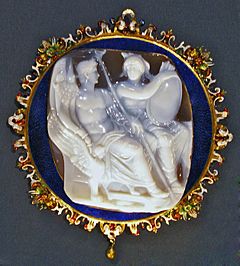
Caligula started some very controversial policies in AD 40. He began to mix religion with his political role. He would appear in public dressed as different gods, like Hercules or Apollo. He reportedly started calling himself a god when meeting with politicians. Some public documents even called him "Jupiter."
He had a special place set aside for his worship in Asia. Two temples were built for him in Rome. The Temple of Castor and Pollux was connected to his palace and dedicated to Caligula. He would sometimes appear there and present himself as a god to the public.
Caligula even had the heads removed from statues of gods in Rome and replaced them with his own head. He wanted to be worshipped as the "New Sun." This was a big change from earlier emperors. Previous emperors were only worshipped as divine after they died. Caligula wanted people in Rome, including senators, to worship him as a living god.
Dealing with the Eastern Provinces
Caligula had to deal with several problems and plots in the eastern parts of the empire. His friend, Herod Agrippa, helped him. Agrippa became governor of some territories in AD 37.
Tensions in the east were complex. They involved the spread of Greek culture and the rights of Jewish people in the empire. Caligula did not trust the governor of Egypt. In AD 38, Caligula sent Agrippa to check on him. This visit led to riots in Alexandria between Greeks and Jews. Caligula responded by removing the governor and executing him.
In AD 39, Agrippa accused his uncle, Herod Antipas, of planning a rebellion. Herod Antipas confessed and was sent away. Agrippa was given his territories. More riots happened in Alexandria in AD 40. Jews were accused of not honoring the emperor.
Caligula then ordered a statue of himself to be placed in the Jewish Temple in Jerusalem. This was a big problem for Jewish people because of their religion. The Roman Governor of Syria, Publius Petronius, delayed carrying out the order. He feared it would cause a civil war. Agrippa finally convinced Caligula to change his mind. However, Caligula issued a second order for his statue to be put in the Temple. Luckily, news of Caligula's death reached the governor before the statue arrived. So, the statue was never installed.
Caligula's Assassination and What Happened Next
Caligula's actions were seen as very harsh towards the Senate and other important Romans. This led to several failed plots against him. Finally, officers in the Praetorian Guard, led by Cassius Chaerea, succeeded in killing the emperor. Many senators, soldiers, and other officials knew about the plot.
The situation became urgent in AD 40 when Caligula announced he planned to leave Rome forever. He wanted to move to Alexandria in Egypt. There, he hoped to be worshipped as a living god. This would have made the Senate and the Praetorian Guard powerless. So, the conspirators decided to act quickly.
On January 24, AD 41, Cassius Chaerea and other guards attacked Caligula. This happened while Caligula was speaking to a group of young performers. Accounts vary, but they agree that Chaerea stabbed Caligula first. Other conspirators then joined in. Caligula's loyal guards arrived, but it was too late. They killed several assassins and innocent bystanders.
Archaeologists found the underground corridor where this event took place in 2008. After Caligula's death, the Senate tried to bring back the Roman Republic. But the military wanted to keep the emperor system. The assassins also killed Caligula's wife, Milonia Caesonia, and their young daughter, Julia Drusilla.
They could not find Caligula's uncle, Claudius. A soldier found Claudius hiding. He was then taken to the Praetorian Guard's camp. Claudius became emperor with the support of the Praetorian Guard. He gave a general pardon, but he did execute some of the officers involved in the plot, including Chaerea.
Caligula's body was quickly buried. Later, his sisters had his body burned and placed in the Mausoleum of Augustus. In AD 410, during the Sack of Rome, his ashes were scattered.
Where Caligula Might Be Buried
On January 17, 2011, police in Nemi, Italy, thought they had found Caligula's burial site. This happened after they arrested a thief with a statue they believed was of the emperor. However, some historians are doubtful about this claim.
Caligula in Books and Movies
In Film and TV Shows
- In the unfinished 1937 film I, Claudius, Caligula was played by Emlyn Williams.
- Ralph Bates played him in the 1968 TV series, The Caesars.
- Jay Robinson played a memorable Caligula in the 1950s films The Robe (1953) and Demetrius and the Gladiators (1954).
- John Hurt played Caligula in the 1976 BBC mini-series I, Claudius.
- The 1979 historical film Caligula starred Malcolm McDowell in the main role.
- David Brandon played him in the 1982 film Caligula... The Untold Story.
- In the 2015 NBC series A.D. The Bible Continues, Andrew Gower played Caligula. His portrayal showed Caligula as dangerous and quick-tempered.
- The third season of the Roman Empire series (on Netflix in 2019) is called Caligula: The Mad Emperor. Ido Drent played Caligula.
- In the BBC show Horrible Histories, Simon Farnaby portrays Caligula.
In Books and Plays
- Caligula is a play by French writer Albert Camus. In the play, Caligula uses his power to do impossible things after his sister Drusilla dies.
- In the novel I, Claudius by Robert Graves, Caligula is shown as a cruel person from childhood. He becomes unstable early in his rule. This novel was made into the 1976 BBC mini-series.
- Caligula appears as a bad guy in the popular young adult book series The Trials of Apollo. He is shown as a minor god who survived into modern times.
In Operas
- A young Caligula appears in Heinrich Ignaz Franz Biber's opera Arminio.
- Caligula is the main character in Detlev Glanert's opera Caligula, which is based on the Albert Camus play.
- Many composers from the Baroque era also wrote operas about Caligula, but most of these works are now lost.
Images for kids
-
Marble portrait of Agrippina, Caligula's mother
-
Marble portrait of Germanicus, Caligula's father
See also
 In Spanish: Calígula para niños
In Spanish: Calígula para niños


